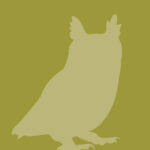
GREAT HORNED OWL
Owls do not have eyeballs which means they cannot move their eyes. Instead they turn their heads up to 270 degrees.
PROFILE
Coy, along with our Turkey Vultures and Red-Shouldered Hawk, came from a Florida wildlife rescue. He was deemed “non-releasable,” which means he needed a permanent home. Hoot also came to us from a breeder as non-releasable due to being imprinted on humans.
Coy is a fully-flighted Great Horned Owl. He was deemed non-releasable because of an inner ear problem that prevents him from being able to fly and hunt properly. It’s sort of like driving with a broken steering wheel. You can usually find him on top of the bird box inside of the Great Horned Owl enclosure. You’ll typically find him on top of the bird box acting like a “decoy.”
OVERVIEW
CONSERVATION STATUS
Least Concern
AVERAGE SIZE
Compared to a 6′ Man
AVERAGE WEIGHT
3 lbs
AVERAGE LIFESPAN
13 Years
DIET
Carnivore
REGIONS
North America
One of the world’s most adaptable species, the great horned owl will take up residence just about anywhere including the trees that border mountains, lakes, deserts and swamps along with caves and the sides of cliffs. They prefer open habitats to hunt in and wooded areas to nest and roost. They try to avoid human interaction but will take up residence in a park-like setting. Young, unattached owls will move about freely while older owls will maintain a territory once they find a mate.
APPEARANCE
Mostly covered with feathers that are a mottled brown pattern, which is perfect for camouflage as it resembles tree bark. The male great horned owl is smaller than the female. They have tufts of feathers above their ears that look like horns, making them easy to identify. They have three ear holes at slightly different sizes and heights which provides precise triangulation of sounds which aids them in hunting in the dark. Mainly nocturnal, they also have very large, yellow-to-amber colored, cylindrical eyes. An owl cannot move its eyes so it turns its head – up to 270°! They have large, feathered legs and toes. Their talons are capable of 300 pounds of crushing pressure.
CHARACTERISTICS
A great horned owl’s diet consists of rabbits and hares, rats and mice, and voles. It freely hunts any animal it can overtake, including rodents and other small mammals, larger mid-sized mammals, birds, reptiles, amphibians, and invertebrates. They, like other birds, will eat their prey whole, later regurgitating the unwanted parts like fur and bones.
Great horned owls do not generally build their own nest but take over abandoned ones. The males court the females, possibly rubbing her beak with his and bringing her gifts of food. They will mate for life, producing on average two eggs per clutch once per year. While the female incubates the eggs over the course of about a month, the male will bring her food. Chicks are born with a cinnamon-buff color down which diminishes by early fall. They are capable of leaving the nest by the time they are 12 weeks old.


